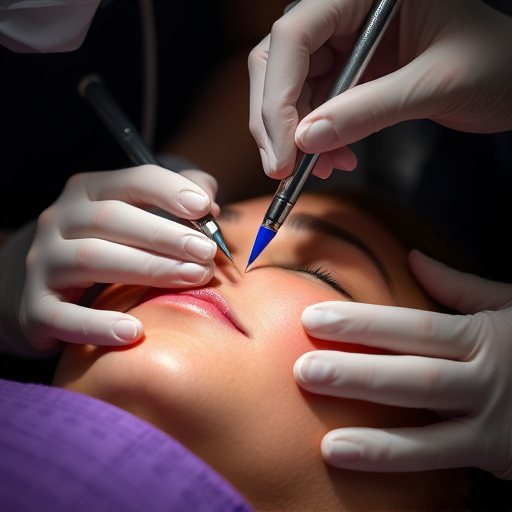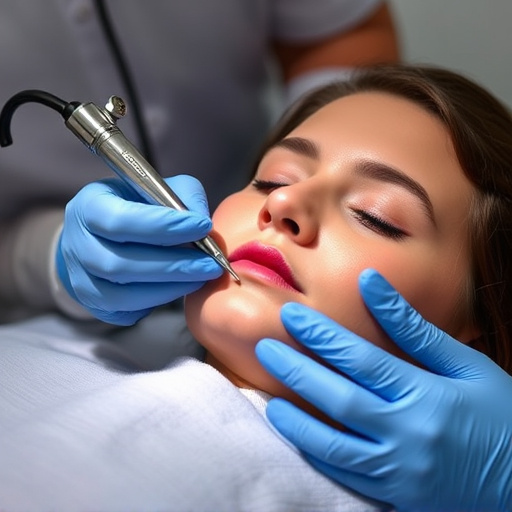Leg laser hair removal is a popular and effective method for achieving smooth, hair-free skin, targeting follicles with lasers to disrupt new hair growth. Results depend on skin tone, hair thickness, and individual factors, typically requiring 6-8 sessions spaced 4-6 weeks apart. Medical spas offer packages combining leg treatments with facial services for a comprehensive approach, optimizing results with strategic planning, consistent skincare, and UV protection.
“Uncover the secrets behind achieving smooth, hair-free legs with leg laser hair removal. This comprehensive guide explores the factors determining the number of sessions required for optimal results. From understanding the treatment process to identifying influences like skin and hair type, you’ll gain insights into what to expect. Learn tips to maximize your laser sessions and discover how to maintain long-lasting results. Whether considering leg laser hair removal for the first time or seeking to optimize existing treatments, this article is your go-to resource.”
- Understanding Leg Laser Hair Removal Treatments
- Factors Influencing the Number of Sessions
- Optimizing Results: Tips and Considerations
Understanding Leg Laser Hair Removal Treatments

Leg laser hair removal is a popular and effective method for achieving smooth, hair-free skin. Understanding the process and what to expect is key to making informed decisions about your treatments. Each session typically focuses on specific areas of the leg, with the laser targeting the pigment in the hair follicles. This technology heats up the follicle, disrupting its ability to produce new hairs, leading to reduced hair growth over time.
The number of sessions required varies based on factors like skin tone, hair thickness, and individual responses. On average, 6-8 sessions are recommended for optimal results, spaced approximately 4-6 weeks apart. Some people may need more or fewer treatments, as the laser cannot target white hairs due to its color-selective properties, and it’s most effective on darker hair in lighter skin tones. Many medical spas offer packages that include consultations and multiple sessions, ensuring a comprehensive approach to leg laser hair removal, alongside other popular facial treatments and non-surgical services.
Factors Influencing the Number of Sessions

The number of sessions required for leg laser hair removal can vary significantly from person to person, depending on several factors. One of the primary influences is the initial hair density and color. Darker hairs absorb the light more efficiently, leading to quicker results, while lighter or finer hairs may need more sessions to achieve significant reduction. Skin type also plays a crucial role; those with darker skin tones might require fewer sessions due to higher melanin content, which enhances the laser’s effectiveness, whereas fairer complexions may be candidates for extended treatments to avoid potential side effects.
Additionally, the overall size and shape of the treatment area on the legs can impact the number of sessions needed. Larger areas will typically take more time and multiple visits to ensure complete hair reduction. Moreover, previous waxing or shaving practices can affect the growth pattern, as hair may become thicker or finer over time, requiring adjustments in treatment frequency. Combining leg laser hair removal with other facial treatments or skin rejuvenation procedures might also influence the overall session count.
Optimizing Results: Tips and Considerations

Optimizing results with leg laser hair removal requires a strategic approach. It’s not just about the number of sessions but also understanding your skin type and hair growth cycles. Typically, for optimal effectiveness, most professionals recommend 6 to 8 sessions spaced approximately 4-6 weeks apart. This allows enough time for each treatment to disrupt the hair growth cycle, ensuring long-lasting results.
To enhance these outcomes, consider combining leg laser hair removal with medical spa services tailored to skin tightening and rejuvenation. Consistent exfoliation, hydration, and protection from UV rays can also improve your skin’s overall health and make laser treatments more efficient. Remember, each person’s experience is unique, so consulting with a qualified specialist can provide personalized guidance for the best results.
Leg laser hair removal is a highly effective method for achieving smooth, hair-free legs. Depending on factors like skin type, hair color, and coarseness, most people require 4-8 sessions spaced several weeks apart. Each session targets both active hair follicles and those in the growth phase, leading to significant reduction in leg hair over time. By understanding these variables and following professional guidance, you can optimize results and enjoy the benefits of lasting hair reduction with leg laser hair removal.














